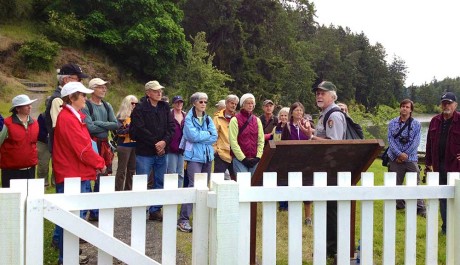2012 National Park Statistics
Posted March 9, 2014 at 3:09 pm by Tim Dustrude
Here’s a report from Mike Vouri, Chief of Interpretation & Historian at San Juan Island National Historical Park….
A new National Park Service (NPS) report shows that more than 261,000 visitors in 2012 spent $14 million in San Juan Island National Historical Park and in communities in the northwest Washington region. That spending supported more than 167 jobs in the area.
Economic statistics for 2013 will be released in 2015.
“San Juan Islanders and our neighbors throughout the region have long recognized the park for its values of a unique history and spectacular natural setting.” said Lee Taylor, superintendent. “What is less known is how the park adds value to the island and region as an economic as well as cultural and nature resource. And that is what this report underscores.”
Boosted by an additional four million visitors in 2012, national parks across the country continued to be important economic engines, generating $26.75 billion in economic activity and supporting 243,000 jobs, according to a peer-reviewed report released yesterday by Secretary Jewell and Director Jarvis.
“In 2012, the National Park Service welcomed more than 280 million visitors to their national parks. For nearly 100 years we have helped people discover places to explore, learn from and enjoy,” said Jarvis. “These places of history, culture and natural wonder offer unparalleled experiences and return $10 for every $1 American taxpayers invest in the National Park Service. That’s a successful formula we can all embrace as we prepare for the next 100 years of the National Park Service.”
More than 200,000 of the jobs supported by national parks in 2012 were in local neighboring communities. These range from big parks like the Grand Canyon, which attracted 4.4 million visitors and supported 6,000 jobs, to smaller parks like the Lincoln Boyhood Home, which had 133,000 visitors and supported 93 jobs in local communities.
This 2012 analysis is a revision from previous reports. Many of the hallmarks of the past model are preserved, but the new model makes significant strides in accuracy and transparency of the analysis. Key changes include new software, updated assumptions about the nation’s economy based on 400 different characteristics, and new estimates of spending and visitor trip characteristics.
The figures in the report are based on spending by nearly 283 million visitors in communities near national parks in 2012. An in-depth analysis of the 2012 figures found an increase in local visitor spending and a correlating increase in economic activity and jobs in local communities.
More than 60,000 visitors crossed the thresholds of San Juan National Historical Park’s visitor centers in 2013, the most recorded in the 47-year history of the park, according to Mike Vouri, the park’s chief of interpretation and visitor services. This figure does not include those visitors who don’t enter the visitor centers.
Jewell and Jarvis also announced estimates of the government shutdown’s impacts on national park gateway economies. Overall, the16-day shutdown resulted in 7.88 million fewer national park visitors in October 2013 compared to a three-year average (October 2010-12), and an estimated loss of $414 million in visitor spending in gateway and local communities across the country when comparing October 2013 to a three-year average (October 2010-12). These losses are part of an economic analysis of the shutdown’s effects on parks and neighboring communities that was released today. While the shutdown figures do not affect the 2012 economics report, they will weigh on the 2013 economics report due out later this year.
The annual economic report, with information by park and by state on visitor spending, jobs and other impacts, and the shutdown report are available online at: http://www.nature.nps.gov/socialscience/economics.cfm
According to the 2012 economic analysis, most visitor spending supports jobs in restaurants, grocery and convenience stores (39 percent), hotels, motels and B&Bs (27 percent), and other amusement and recreation (20 percent).
For more state-by-state information about national parks and how the National Park Service is working with communities go to www.nps.gov/[statename], for example: http://www.nps.gov/virginia.
Mike Vouri
Chief of Interpretation & Historian
San Juan Island National Historical Park
You can support the San Juan Update by doing business with our loyal advertisers, and by making a one-time contribution or a recurring donation.
Categories: Around Here











No comments yet. Be the first!
By submitting a comment you grant the San Juan Update a perpetual license to reproduce your words and name/web site in attribution. Inappropriate, irrelevant and contentious comments may not be published at an admin's discretion. Your email is used for verification purposes only, it will never be shared.